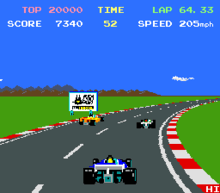Pole Position II
| Pole Position II | |
|---|---|
 North American arcade flyer | |
| Developer(s) | Namco |
| Publisher(s) | |
| Designer(s) | Tōru Iwatani |
| Platform(s) |
Arcade (original) Atari 7800, Commodore 64, Epoch Super Cassette Vision, MS-DOS |
| Release | |
| Genre(s) | Racing |
| Mode(s) | Single-player |
| Cabinet | Upright and environmental |
| Arcade system | Namco Pole Position |
| CPU |
1x ZiLOG Z80 @ 3.072 MHz, 2x Z8002 @ 3.072 MHz, 1x MB8844 @ 256 kHz |
| Sound |
1x Namco WSG @ 48 kHz, 1x Namco 52XX @ 1.536 MHz |
| Display | Horizontal orientation, Raster, 256 x 224 resolution |
Pole Position II (Japanese: ポールポジションII Hepburn: Pōru Pojishon Tsū) is the sequel to racing arcade game Pole Position, released by Namco in 1983. As with its predecessor, Namco licensed this game to Atari, Inc. for US manufacture and distribution, who also released a port of it as the pack-in game for their Atari 7800 ProSystem console. Pole Position arcade machines can be converted to Pole Position II by swapping several chips.[1]
The gameplay is the same as in original Pole Position with three additional tracks to choose from: Test (resembling Indianapolis Motor Speedway), Seaside (resembling the 1982 United States Grand Prix West circuit in Long Beach), and Suzuka.
Minor differences from the original

The cars have a different color scheme, the explosions now show debris, there are several new billboards, and there is a new opening theme song. The timer is displayed as "TIME" in the Japanese version (as it was in the original game), and it is displayed as "UNIT" in the American release.
Re-releases
Pole Position II has been re-released as part of various Namco Museum compilations, but the two active permanent circuits were removed (because of licensing issues with both Fuji and Suzuka), and similar looking circuits, Namco Circuit and Wonder Circuit (after Namco's Wonder series of Japanese theme parks) respectively. In Namco Museum Virtual Arcade, they were renamed to Blue and Orange respectively, even though neither track features the colors. The layouts were similar.
In 2006, Namco Networks released Pole Position II for mobile phones.[2]
References
- ↑ Pole Position II at the Killer List of Videogames
- ↑ IGN review of Pole Position II cell phone game Archived 2006-03-16 at the Wayback Machine.
External links
- Pole Position II at the Killer List of Videogames
- Pole Position II at the Arcade History database